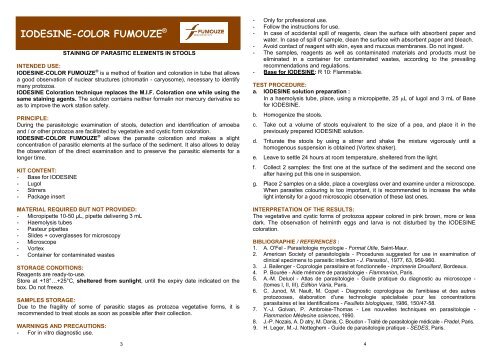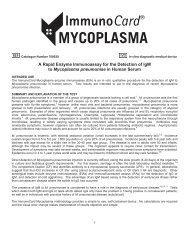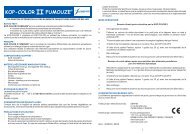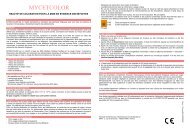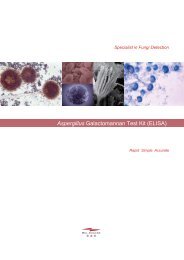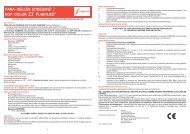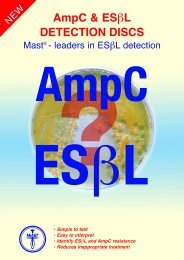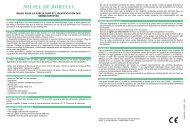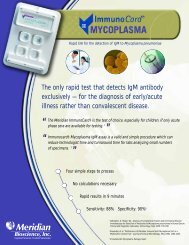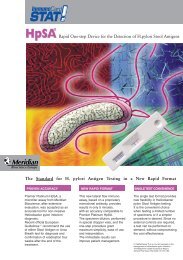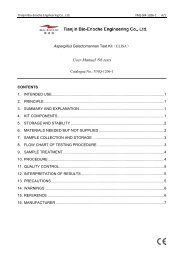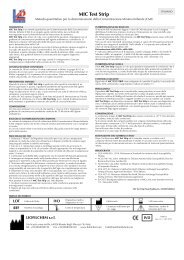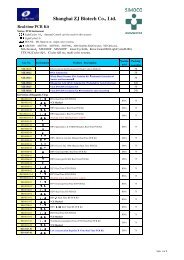IODESINE-COLOR FUMOUZE® - Simoco Diagnostics
IODESINE-COLOR FUMOUZE® - Simoco Diagnostics
IODESINE-COLOR FUMOUZE® - Simoco Diagnostics
- No tags were found...
You also want an ePaper? Increase the reach of your titles
YUMPU automatically turns print PDFs into web optimized ePapers that Google loves.
<strong>IODESINE</strong>-<strong>COLOR</strong> FUMOUZE ®STAINING OF PARASITIC ELEMENTS IN STOOLSINTENDED USE:<strong>IODESINE</strong>-<strong>COLOR</strong> FUMOUZE ® is a method of fixation and coloration in tube that allowsa good observation of nuclear structures (chromatin - caryosome), necessary to identifymany protozoa.<strong>IODESINE</strong> Coloration technique replaces the M.I.F. Coloration one while using thesame staining agents. The solution contains neither formalin nor mercury derivative soas to improve the work station safety.PRINCIPLE:During the parasitologic examination of stools, detection and identification of amoebaand / or other protozoa are facilitated by vegetative and cystic form coloration.<strong>IODESINE</strong>-<strong>COLOR</strong> FUMOUZE ® allows the parasite coloration and makes a slightconcentration of parasitic elements at the surface of the sediment. It also allows to delaythe observation of the direct examination and to preserve the parasitic elements for alonger time.KIT CONTENT:- Base for <strong>IODESINE</strong>- Lugol- Stirrers- Package insertMATERIAL REQUIRED BUT NOT PROVIDED:- Micropipette 10-50 µL, pipette delivering 3 mL- Haemolysis tubes- Pasteur pipettes- Slides + coverglasses for microscopy- Microscope- Vortex- Container for contaminated wastesSTORAGE CONDITIONS:Reagents are ready-to-use.Store at +18°…+25°C, sheltered from sunlight, until the expiry date indicated on thebox. Do not freeze.SAMPLES STORAGE:Due to the fragility of some of parasitic stages as protozoa vegetative forms, it isrecommended to treat stools as soon as possible after their collection.WARNINGS AND PRECAUTIONS:- For in vitro diagnostic use.- Only for professional use.- Follow the instructions for use.- In case of accidental spill of reagents, clean the surface with absorbent paper andwater. In case of spill of sample, clean the surface with absorbent paper and bleach.- Avoid contact of reagent with skin, eyes and mucous membranes. Do not ingest.- The samples, reagents as well as contaminated materials and products must beeliminated in a container for contaminated wastes, according to the prevailingrecommendations and regulations.- Base for <strong>IODESINE</strong>: R 10: Flammable.TEST PROCEDURE:a. <strong>IODESINE</strong> solution preparation :In a haemolysis tube, place, using a micropipette, 25 µL of lugol and 3 mL of Basefor <strong>IODESINE</strong>.b. Homogenize the stools.c. Take out a volume of stools equivalent to the size of a pea, and place it in thepreviously prepared <strong>IODESINE</strong> solution.d. Triturate the stools by using a stirrer and shake the mixture vigorously until ahomogenous suspension is obtained (Vortex shaker).e. Leave to settle 24 hours at room temperature, sheltered from the light.f. Collect 2 samples: the first one at the surface of the sediment and the second oneafter having put this one in suspension.g. Place 2 samples on a slide, place a coverglass over and examine under a microscope.When parasites colouring is too important, it is recommended to increase the whitelight intensity for a good microscopic observation of these last ones.INTERPRETATION OF THE RESULTS:The vegetative and cystic forms of protozoa appear colored in pink brown, more or lessdark. The observation of helminth eggs and larva is not disturbed by the <strong>IODESINE</strong>coloration.BIBLIOGRAPHIE / REFERENCES :1. A. O'Fel - Parasitologie mycologie - Format Utile, Saint-Maur.2. American Society of parasitologists - Procedures suggested for use in examination ofclinical specimens to parasitic infection - J. Parasitol., 1977, 63, 959-960.3. J. Bailenger - Coprologie parasitaire et fonctionnelle - Imprimerie Drouillard, Bordeaux.4. P. Bourée - Aide mémoire de parasitologie - Flammarion, Paris.5. A.-M. Deluol - Atlas de parasitologie - Guide pratique du diagnostic au microscope -(tomes I, II, III). Edition Varia, Paris.6. C. Junod, M. Nault, M. Copet - Diagnostic coprologique de l'amibiase et des autresprotozooses, élaboration d'une technologie spécialisée pour les concentrationsparasitaires et les identifications - Feuillets biologiques, 1986, 150/47-58.7. Y.-J. Golvan, P. Ambroise-Thomas - Les nouvelles techniques en parasitologie -Flammarion Médecine sciences, 1990.8. J.-P. Nozais, A. D atry, M. Danis, C. Boudon - Traité de parasitologie médicale - Pradel, Paris.9. H. Leger, M.-J. Notteghem - Guide de parasitologie pratique - SEDES, Paris.3 4


